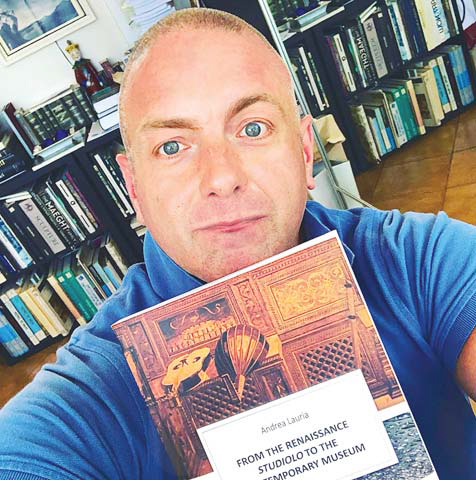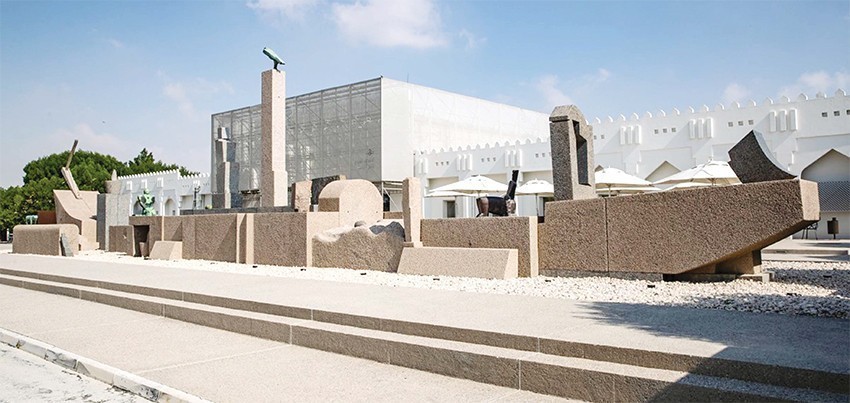25/05/2023
25/05/2023
‘Class’ … in session

Andrea Lauria is an Italian museologist graduated from Rome’s Accademy of fine arts. He also holds a History of Art degree from University di Roma Tre in Rome. Andrea Lauria lectures a Masters course in museology at Rome’s Universities Tor Vergata and American Temple University (Rome Campus). In 2020 he has become a published author of the book: “From the Renaissance studiolo to the contemporary museum” which is also his course manual. Lauria’s field of research is the phenomenon of hyper-museums with special attention to the Arabian countries in comparison with the western world.

Today I won’t write about an important hyper museum or an incredible land mark but about an interesting museum for modern and contemporary art in the Gulf. We are going to discover together the Mathaf. Mathaf (‘museum’ in Arabic) is a modern, contemporary museum in Doha, Qatar dedicated to Arab culture and creativity. The museum displays a permanent collection of over 9,000 objects, offering a unique and comprehensive overview of Arab modern and contemporary art from North Africa to the Middle East. The museum also offers temporary exhibitions, library, and a strong educational program with the aim to become a vital center for dialogue and scholarship in the Gulf.
Mathaf was opened by Qatar Museums (QM) in partnership with Qatar Foundation (QF) in 2010 and is located in Doha’s Education City. The museum is considered to be among the most important cultural attractions in the country. Mathaf today houses the world’s largest collection of modern and contemporary Arab art but the initial collection was started by Sheikh Hassan bin Mohammed Al-Thani.
Later the collection turned in to the public institution under authority of QMA (formerly the Qatar Museums Authority) now named Qatar Museums (QM) a Qatari government entity that oversees also the Museum of Islamic Art (MIA), MIA Park, QM Gallery at the Katara Cultural Village.
Qatar Museums (QM) is overseen by a board of trustees headed by Sheikha Al-Mayassa bint Hamad bin Khalifa Al-Thani. I have mentioned Sheikha Al- Mayassa before, in my article about National museum of Qatar designed by Jean Nouvel, as one of the most infl uential people in art on Art Auction’s top- 10 list and Art Review’s Power 100, and Forbes’ The World’s 100 Most Powerful Women.
The current museum’s site was opened in 2010 but the collection is older and was started by Sheikh Hassan who began to collect in the early 1990s. He gathered art works from the Arab world over the last 200 years with the aim of creating a museum that could represent artists from this Arab world with the oldest pieces in the collection dating as early as the 1840s.
The collection was initially from the 1990s and early 2000s, housed in two private villas in Madinat Khalifa in Doha while Sheikh Hassan and early advisors conceived of an idea of what an Arab perspective on modern and contemporary art and museums could be. The works on display are presented through different art forms – from paintings and mixed media to sculpture. The bilingual Mathaf Encyclopedia -- a scholarly resource providing basic facts and in depth information on modern art of the Arab world, is available online, free of charge.
Mathaf for sure offers a very interesting perspective on the modern and contemporary art and when it opened in 2010 it was the first museum dedicated to modern and contemporary art in the country, the building itself it is modern but cannot be considered a hyper-museum. The building that hosts temporarily Mathaf is the former school building transformed by the French architect Jean-François Bodin. The museum’s exhibitions are housed in a 5,500 m2 facility that includes galleries on two fl oors, café, museum shop, a research library and an education wing. The Museum building is located in Doha’s Education City, QM will determine its plans for the construction of a future, permanent home for the Museum at a later date.
As I said the former school was redesigned by the French architect Jean-François Bodin, an interesting designer but not internationally knwown like famous Archi stars Jean Nouvel (architect of the National Museum of Qatar in Doha) or I. M. Pei (architect of the Museum of Islamic Art in Doha). The building itself is a celebration of high-mindedness and education as renovated and architect urally transformed former school. Mathaf it is not an hyper-museum, it means it is not the first work of art of the collection that we are going to visit or a strong land mark, as you have learned from by my past article. However Mathaf’s building is an example of recycled architecture that purposefully complements the building’s former identity as a space for learning and exploration.
Even though the building is only designed to be a temporary house for the museum, it is a worthy home for the collection and conceptually interesting. The building seen form represents certainly the typical Arab architecture in a mix between a military fort and the typical architecture of the medinas. As I have already said the building itself is not a piece of art, as the Nouvel’s National Museum of Qatar, but the architect building’s reinterpretation of the old Qatari school is not bad. Its renovation is particularly effective at night when the excellent external lighting brings out the white color of the building making it especially intriguing, an interesting design object perfect to host the contemporary art museum.
The museum’s visitors can access the building through a terrace that features a shaded outdoor seating area which is part of the café. From the terrace, visitors will be able to pass through a screen-wrapped scaffolding-style façade, upon which imagery and videos can be projected at night. The inside spaces, more interesting than the building’s architecture, have minimal sober aesthetic, fl exible and informal as well. Mathaf permanent collection exhibition occupies seven galleries in the upper fl oor, while the atrium and five galleries are dedicated to temporary exhibitions.
The museum focuses at major modern and contemporary movements represented in the collection. Mathaf was the second new art museum to open in Doha in three years, following the Museum of Islamic Art, of which I wrote about weeks ago, that features a large collection of Islamic art and artifacts housed in a museum designed by the famous Chinese-born American architect I.M. Pei. The museums are part of an effort by Qatar’s ruling family to develop the big museums’ district in country. If the opening of the Museum of Islamic Art, created a place to study and appreciate the Islamic art with the opening of Mathaf, Qatar has created a museum to explore and discuss the creations of Arab artists of the modern and contemporary art scene.
Qatar demonstrates that developing a serious cultural program and the Mathaf’s collection expresses a balance between the old with the strong Mathaf’s commitment to education. I have expressed many time my love for the architectural work of Archi-Star Jean Novel in general and how much I like the National Museum of Qatar designed by him. He has designed also the Louvre A.D., and its National Museum of Qatar is a wonderful example of a hyper-museum, which brings Qatar authoritatively into to the scene of world hyper-museums. The museum itself is the principal piece of art of the collection and, as in cases of Guggenheim in New York or in Bilbao, we are going to visit primarily the building not the collection or the museum’s content. If the Mathaf’s collection offers successfully an Arab perspective on modern and contemporary art and the museums for sure supports creativity, promotes dialogue and inspires new ideas I think that this collection should have a spectacular seat a hyper- museums designed by another famous Archi-star.
By Andrea Lauria Prof.


